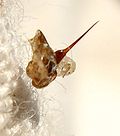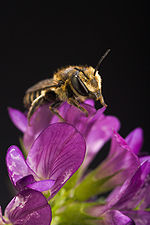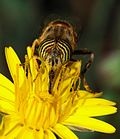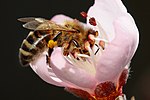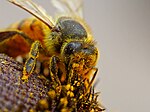vapor. Honey bee pheromones can be grouped into releaser pheromones which temporarily affect the recipient's behavior, and primer pheromones which have...
16 KB (2,123 words) - 20:20, 8 September 2024
communication between individuals, through both pheromones and the dance language. The western honey bee was one of the first domesticated insects, and it is...
96 KB (11,435 words) - 01:13, 6 January 2025
being alerted to this by the release of attack pheromones (below). Although it is widely believed that a worker honey bee can sting only once, this is a partial...
14 KB (1,582 words) - 17:04, 21 November 2024
Nasonov pheromone can be used to attract a honey bee swarm to an unoccupied hive or a swarm-catching box. Synthetically produced Nasonov consists of citral...
6 KB (595 words) - 10:53, 22 May 2024
Beekeeping (redirect from Bee-keeping)
maintenance of bee colonies, commonly in artificial beehives. Honey bees in the genus Apis are the most commonly kept species but other honey producing bees such...
91 KB (10,196 words) - 14:11, 24 December 2024
Stingless bees (SB), sometimes called stingless honey bees or simply meliponines, are a large group of bees (from about 462 to 552 described species)...
107 KB (12,169 words) - 05:14, 6 January 2025
honey bee (also spelled honeybee) is a eusocial flying insect within the genus Apis of the bee clade, all native to mainland Afro-Eurasia. After bees...
100 KB (11,754 words) - 11:51, 27 December 2024
Honey is a sweet and viscous substance made by several species of bees, the best-known of which are honey bees. Honey is made and stored to nourish bee...
121 KB (13,077 words) - 16:05, 5 January 2025
other than honey bees, particularly the European honey bee (Apis mellifera). Worker bees of this variety are responsible for approximately 80% of the world's...
21 KB (2,601 words) - 20:34, 3 November 2024
Asian giant hornet (redirect from Bee ball)
pheromones to lead its nest-mates to the hive. The hornets can devastate a colony of honey bees, especially if it is the introduced western honey bee...
96 KB (10,204 words) - 20:16, 10 January 2025
There are alarm pheromones, food trail pheromones, sex pheromones, and many others that affect behavior or physiology. Pheromones are used by many organisms...
54 KB (6,259 words) - 02:41, 4 January 2025
Apis andreniformis (redirect from Black dwarf honey bee)
the black dwarf honey bee, is a relatively rare species of honey bee whose native habitat is the tropical and subtropical regions of Southeast Asia. A...
18 KB (2,266 words) - 20:30, 13 January 2024
Megachile rotundata (redirect from Alfalfa leafcutter bee)
half as painful as a honey bee's. Megachile rotundata is a member of the subfamily Megachilinae, which includes more than 4,000 bee species; this currently...
30 KB (3,626 words) - 15:45, 22 August 2024
Bumblebee (redirect from Bumble Bee)
form colonies with a single queen. The colonies are smaller than those of honey bees, growing to as few as 50 individuals in a nest. Cuckoo bumblebees are...
108 KB (11,623 words) - 21:13, 2 January 2025
Meliponiculture (category Bees)
western honey bee or European honey bee; Apini tribe). In meliponiculture, the hives can be organized in meliponary, places with suitable conditions of temperature...
35 KB (3,468 words) - 21:39, 21 November 2024
Pollinator (category CS1 maint: numeric names: authors list)
who is trying to produce honey. Millions of hives of honey bees are contracted out as pollinators by beekeepers, and honey bees are by far the most important...
49 KB (5,594 words) - 23:52, 27 August 2024
will be no more honey without the bees to produce it, and Professor Frink has an uninfected queen bee sting Lisa, releasing pheromones which attract many...
13 KB (1,446 words) - 10:23, 4 January 2025
more analogous to the foraging patterns of the honey bee, another social insect. This algorithm is a member of the ant colony algorithms family, in swarm...
77 KB (9,484 words) - 14:18, 30 December 2024
Hockett's design features (redirect from Design features of language)
colony. When an ant is killed, it releases a pheromone that alerts others of potential danger. Pheromones also help ants distinguish family members from...
16 KB (2,210 words) - 13:54, 24 September 2024
Alison Mercer (category Academic staff of the University of Otago)
effects of chemicals on bees. She was nicknamed the "Queen of all pheromones" by Otago Daily Times for her work in discovering that exposing a young bee to...
8 KB (1,029 words) - 21:44, 24 October 2024
Trophallaxis (category CS1 maint: multiple names: authors list)
can involve the transfer of molecules such as pheromones, organisms such as symbionts, and information to serve as a form of communication. Trophallaxis...
16 KB (1,981 words) - 01:02, 29 October 2024
believed to be an alarm pheromone, 2-heptanone has been shown to act as an anaesthetic on the pests, enabling the honey bee to stun the pest and eject...
9 KB (871 words) - 21:49, 12 June 2024
Fear (redirect from Fear of the unknown)
other rats to move away from the source of the signal. After the discovery of pheromones in 1959, alarm pheromones were first described in 1968 in ants and...
102 KB (12,362 words) - 21:38, 29 December 2024
Fruit tree pollination (category Bee ecology)
attraction of honey bees to pear blossoms is to use bee attractants to entice the bees to pollinate the flowers.Bee attractants may include pheromones that...
21 KB (2,669 words) - 17:42, 3 February 2024
Trigona spinipes (category CS1 maint: multiple names: authors list)
rufiventris bees and take over their food. Some hypothesize that honey bee dance evolved to prevent eavesdropping espionage of this sort. The pheromone signal...
22 KB (2,754 words) - 19:59, 29 December 2023
commonly named as esters of those acids, as in glyceryl 1,2-dioleate 3-palmitate, the name for a brood pheromone of the honey bee. Where the fatty acid residues...
20 KB (2,317 words) - 15:16, 12 November 2024
Bombus occidentalis (redirect from Western Bumble Bee)
could have come because of the invasion of European honey bees. A recent study in 2016 suggests that the Western bumble bee population is rebounding...
25 KB (3,038 words) - 15:31, 10 November 2024
Bombus terrestris (category Bees described in 1758)
responsive to this foraging pheromone. Conversely, in colonies with ample food reserves bees will be less responsive to these pheromones likely to save time and...
57 KB (6,601 words) - 03:01, 29 September 2024
Entomophily (redirect from Bee and flower)
patterns (honey guides) leading to rewards of pollen and nectar; they may also have an attractive scent which in some cases mimics insect pheromones. Insect...
21 KB (2,350 words) - 21:27, 15 December 2024


